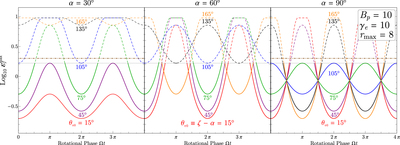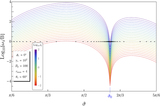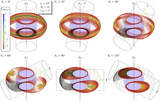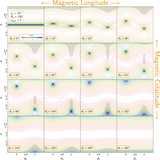Image Details

Caption: Figure 5.
Maximum resonant cutoff energy ﹩{\varepsilon }_{f}^{\max }﹩ from Equation (33) as a function of rotation phase, for oblique rotators with different magnetic axis inclination angles ﹩\alpha =30^\circ ,60^\circ ,90^\circ ﹩ (panels as labeled) to the rotation axis. For each panel, profiles are depicted for several choices of the viewing angle at the zero-phase instant (﹩{\rm{\Omega }}t=0﹩), with ﹩{\theta }_{v0}\equiv \zeta -\alpha ﹩ values labeled. The cutoff energies are modulated by the stellar rotation and correspond to monoenergetic electrons with an azimuthally symmetric density distribution about the magnetic axis. The electrons are presumed to populate meridional magnetic loops that extend to altitudes ﹩{r}_{\max }=8﹩, propagating from the south magnetic footpoint to its northern counterpart. The heavyweight solid portions of the curves are for the maximum soft photon energy being constrained such that ﹩{B}_{\mathrm{local}}/{\gamma }_{e}\lt {\varepsilon }_{s}^{\max }={10}^{-2}﹩, i.e., sampling the bulk of the surface X-rays. In contrast, the dashed portions of the curves are unconstrained; see text for a discussion. Also shown in the left and right panels are horizontal dot-dashed lines that represent the absolute magnetic pair creation threshold of ﹩2{m}_{e}{c}^{2}﹩.
Copyright and Terms & Conditions
© 2018. The American Astronomical Society. All rights reserved.












